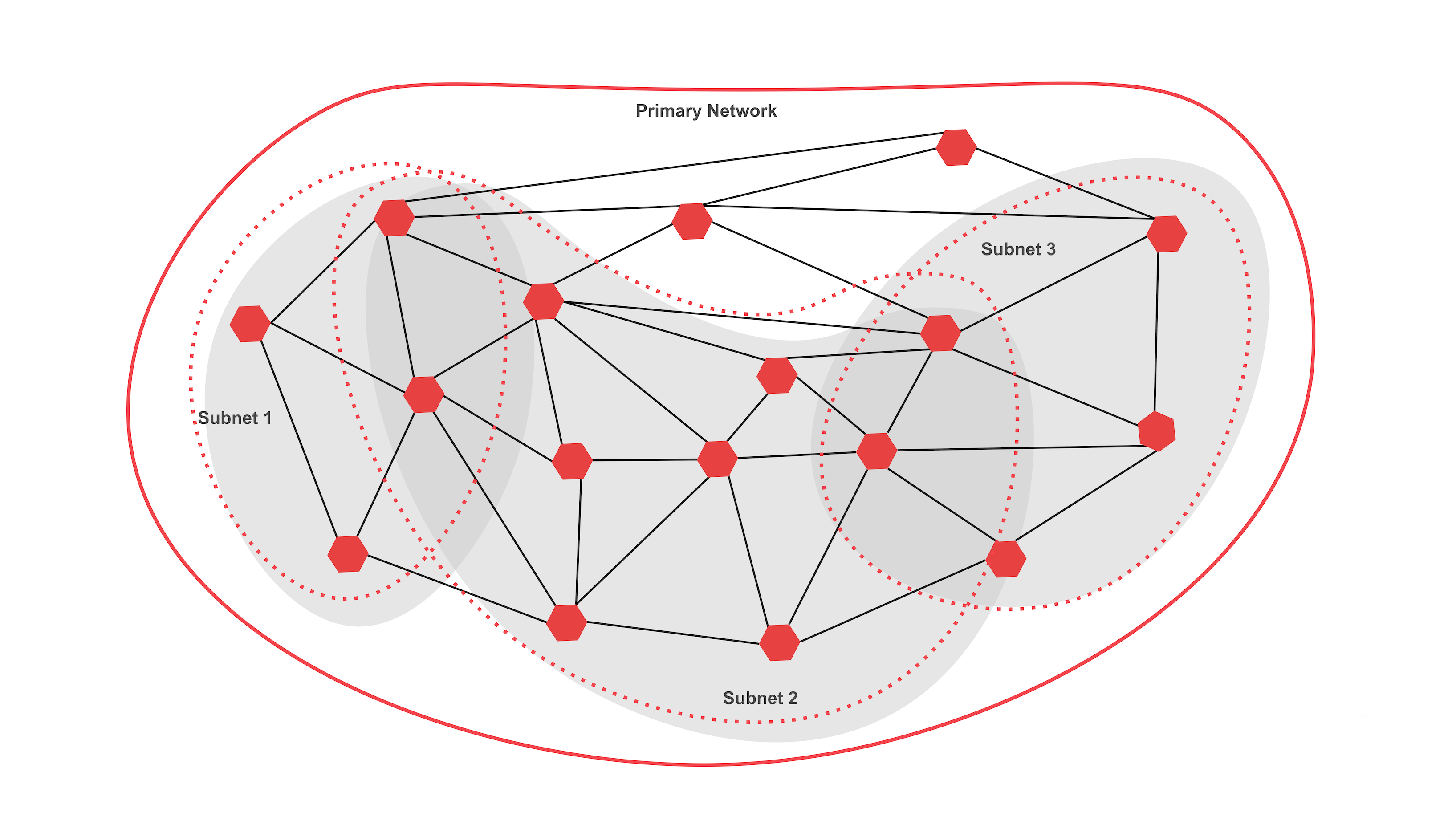Subnets Overview
A Subnet is a sovereign network which defines its own rules regarding its membership and token economics. It is composed of a dynamic subset of Metal validators working together to achieve consensus on the state of one or more blockchains. Each blockchain is validated by exactly one Subnet, and a Subnet can have many blockchains. A validator may be a member of many Subnets.
Metal's 4 built-in blockchains: Platform Chain (P-Chain), Contract Chain (C-Chain), Proton Chain (A-Chain) and Exchange Chain (X-Chain) are validated and secured by all the Metal validators which compose a special Subnet and is referred as the Primary Network.
By definition, all Subnet validators must also validate the Metal Primary Network.

Subnets are independent, they specify their own execution logic, determine their own fee regime, maintain their own state, facilitate their own networking, and provide their own security. They don’t share execution thread, storage1 or networking with other Subnets including the Primary Network, effectively allowing the network to scale up easily while enabling lower latency, higher transactions per second (TPS), and lower transaction costs provided by the Metal Consensus.
Advantages
A Subnet manages its own membership, it can create its own token economics and rules, and may require that its constituent validators have certain properties.
Independent Token Economics
Subnets can have their own token economics with their own native tokens and fee markets. They can launch their own blockchains with customized virtual machines. See Customize a Subnet for more details.
Compliance
Metal’s Subnet architecture makes regulatory compliance manageable. As mentioned above, a Subnet may require validators to meet a set of requirements.
Some examples of requirements include:
- Validators must be located in a given country
- Validators must pass a KYC/AML checks
- Validators must hold a certain license
(To be abundantly clear, the above examples are just that: examples. These requirements do not apply to the Metal Primary Network.)
Application-Specific Requirements
Different blockchain-based applications may require validators to have certain properties. Suppose there is an application that requires large amounts of RAM or CPU power. A Subnet could require that validators meet certain hardware requirements so that the application doesn’t suffer from low performance due to slow validators.
Support for Private Blockchains
You can create a Subnet where only certain pre-defined validators may join and create a private Subnet where the contents of the blockchains would be visible only to those validators. This is ideal for organizations interested in keeping their information private. See here for more info.
Separation of Concerns
In a heterogeneous network of blockchains, some validators will not want to validate certain blockchains because they simply have no interest in those blockchains. The Subnet model allows validators to only concern themselves with blockchains that they care about. This reduces the burden on validators.
Validators
Incentives are provided by Subnet owners in order to attract Metal validators to validate their Subnet, and this incentive can be customized by the Subnet. Validators must also take security and resource concerns into consideration when deciding whether to validate a given Subnet.
Virtual Machines
A Virtual Machine (VM) defines the application-level logic of a blockchain. In technical terms, it specifies the blockchain’s state, state transition function, transactions, and the API through which users can interact with the blockchain. Every blockchain on Metal Blockchain is an instance of a VM.
When you write a VM, you don't need to concern yourself with lower-level logic like networking, consensus, and the structure of the blockchain. Metal Blockchain does this behind the scenes so you can focus on the thing you would like to build.
Think of a VM as a blueprint for a blockchain; you can use the same VM to create many blockchains, each of which follows the same rule-set but is logically independent of other blockchains.
Why Virtual Machines?
At first, blockchain networks had one Virtual Machine (VM) with a pre-defined, static set of functionality. This rigid, monolithic design limited what blockchain-based applications one could run on such networks.
People who wanted custom decentralized applications had to create their own, entirely new blockchain network from scratch. Doing so required a great deal of time and effort, offered limited security, and generally resulted in a bespoke, fragile blockchain that never got off the ground.
Ethereum made a step toward solving this problem with smart contracts. Developers didn’t need to worry about networking and consensus, but creating decentralized applications was still hard. The Ethereum VM has low performance and imposes restrictions on smart contract developers. Solidity and the other few languages for writing Ethereum smart contracts are unfamiliar to most programmers.
Metal Virtual Machines make it easy to define a blockchain-based decentralized application. Rather than new, limited languages like Solidity, developers can write VMs in Go (other languages will be supported in the future).
Developing Your Own Subnet
Please check out documents listed on the left panel to develop your own Subnets with customized virtual machines and blockchains.
- Subnets do not share storage in logical level (keys/values) with other Subnets, but they share storage on disk level (LevelDB) and store their data into same database/folder in operating system.↩